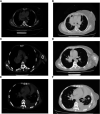Case report: Hilar metastasis of breast cancer: A single-center retrospective case-control study
- PMID: 36896259
- PMCID: PMC9989156
- DOI: 10.3389/fsurg.2023.1025287
Case report: Hilar metastasis of breast cancer: A single-center retrospective case-control study
Abstract
Purpose: The lungs are a common metastatic organ in breast cancer, mainly due to blood metastasis. On imaging, most metastatic lesions show a peripheral round mass in the lung, occasionally with a hilar mass as the primary manifestation, showing burr and lobulation signs. This study aimed to investigate breast cancer patient's clinical characteristics and prognosis with two different metastatic sites in the lung.
Methods: We retrospectively analyzed patients admitted to the First Hospital of Jilin University between 2016 and 2021 diagnosed with breast cancer lung metastases. Forty breast cancer patients with hilar metastases (HM) and 40 patients with peripheral lung metastases (PLM) were matched 1:1 using a pairing method. To analyze the patient's prognosis, the clinical characteristics of patients with two different metastatic sites were compared using the chi-square test, Kaplan-Meier curve, and Cox proportional hazards model.
Results: The median follow-up time was 38 months (2-91 months). The median age of patients with HM was 56 years (25-75 years), and that of patients with PLM was 59 years (44-82 years). The median overall survival (mOS) was 27 months in the HM group and 42 months in the PLM group (p = 0.001). The results of the Cox proportional hazards model showed that the histological grade (hazard ratio = 2.741, 95% confidence interval 1.442-5.208, p = 0.002) was a prognostic factor in the HM group.
Conclusion: The number of young patients in the HM group was higher than that in the PLM group, with higher Ki-67 indexes and histological grades. Most patients had mediastinal lymph node metastasis, with shorter DFI and OS and poor prognosis.
Keywords: breast cancer; hilar metastasis; overall survival; peripheral lung metastasis; prognosis.
© 2023 Yang, Jia, Lv and Cui.
Conflict of interest statement
The authors declare that the research was conducted in the absence of any commercial or financial relationships that could be construed as a potential conflict of interest.
Figures




Similar articles
-
Prognostic significance of metastasis to the highest mediastinal lymph node in nonsmall cell lung cancer.Ann Thorac Surg. 2006 Jan;81(1):292-7. doi: 10.1016/j.athoracsur.2005.06.077. Ann Thorac Surg. 2006. PMID: 16368383
-
Classification for long-term survival in oligometastatic patients treated with ablative radiotherapy: A multi-institutional pooled analysis.PLoS One. 2018 Apr 12;13(4):e0195149. doi: 10.1371/journal.pone.0195149. eCollection 2018. PLoS One. 2018. PMID: 29649281 Free PMC article.
-
Characteristics of clinical N0 metastatic non-small cell lung cancer.Lung Cancer. 2015 Jul;89(1):71-5. doi: 10.1016/j.lungcan.2015.04.002. Epub 2015 Apr 13. Lung Cancer. 2015. PMID: 25913230
-
A large-cohort retrospective study of metastatic patterns and prognostic outcomes between inflammatory and non-inflammatory breast cancer.Ther Adv Med Oncol. 2020 Jun 7;12:1758835920932674. doi: 10.1177/1758835920932674. eCollection 2020. Ther Adv Med Oncol. 2020. PMID: 32550867 Free PMC article.
-
Stereotactic Body Radiation Therapy (SBRT) for Oligorecurrent/Oligoprogressive Mediastinal and Hilar Lymph Node Metastasis: A Systematic Review.Cancers (Basel). 2022 May 28;14(11):2680. doi: 10.3390/cancers14112680. Cancers (Basel). 2022. PMID: 35681659 Free PMC article. Review.
References
Publication types
LinkOut - more resources
Full Text Sources

